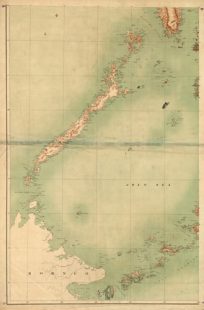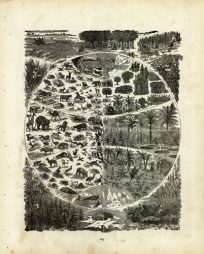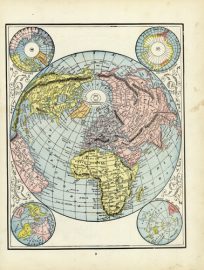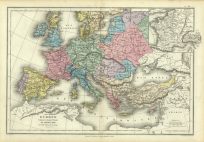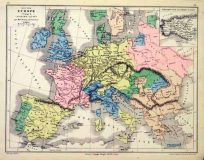How to Detect Reproductions?
When purchasing maps always buy from an established and reliable dealer. Ask the antique map dealer how long they have been in business. Most dealers are honest and would never try to deceive a customer.
Reproductions are copies, often photographically produced, which were printed after the production of originals ceased. Reproductions are not necessarily recent. A number of 19th-century reproductions exist, some of excellent quality. A few reproductions can be detected only by experts, but most can be discerned with a little experience. Some of the factors to be considered in distinguishing reproductions are listed below.
SIZE
Reproductions not intended to deceive are often produced slightly larger or smaller than the original. Of course, the size of the original must be known.
COLORING
Colored reproductions often employ halftone colors. These consist of patterns of small dots, geometrically arranged, which can be seen easily using a magnifying glass. Some reproductions, however, are hand colored, just like the originals.
PRINTING QUALITY
Sometimes reproductions have slightly blurred lines, or finely hatched areas may fuse together. It can be difficult to judge this, unfortunately, unless a known original is available for comparison.
PLATE MARK
When an engraved map is printed, the impression of the metal plate crushes the paper, resulting in a depressed area extending to just outside the printed area. This usually can be felt or seen. Woodcut maps do not have such a plate mark, and sometimes it is not apparent on engraved maps. Occasionally a fake plate mark is added to reproductions to add “realism.”
LEGENDS
Many reproductions carry notations such as “Copyright 1958” or “From an original in the Library of Congress.” Although this may appear obvious, personal experience indicates that people do not always notice such things. The notations are sometimes outside the border and can be trimmed off or erased.
PAPER
On maps made before about l800 look for chain marks. Also look for any watermarks. Unfortunately, some reproductions are produced on paper designed to look old. This usually does not deceive an experienced collector or dealer, but the novice should beware. Originals also usually show some signs of age and use such as spotting, stains, browning, a limp quality, deterioration of the paper caused by the coloring, or offsetting of the color or printer’s ink.
AGING PROCESS
Old paper usually looks old. The edges will be slightly worn and perhaps soiled. If you’re in doubt most experienced map dealers can identify reproductions without difficulty.
The above suggestions will decide the issue in most cases. However, before investing money, it is best to check with an experienced dealer or collector. Some dealers may charge a nominal fee for authenticating an old map. Local libraries or art galleries may also be willing to help you.
In any case it is best to buy from established dealers who will guarantee the authenticity of their stock.
Reprinted with permission.Originally copyrighted by David C. Jolly. Subsequently published with permission in Antique Map Price Record & Handbook by Jon K. Rosenthal.
FAQ
- What is Meant by the Term “Antique Map”?
- Condition of Maps & Prints
- Sizes of Antique Maps
- Coloring of Antique Maps
- Map & Print Collecting Terms
- Factors Affecting a Map’s Value
- What Should I Collect?
- What Should I Pay?
- The Care of Maps & Prints
- How to Detect Reproductions
History of Print Making
- Wood Block
- Line Engraving
- Etching
- Mezzotint-Engraving
- Stipple Engraving
- Aquatint Engravings
- Lithographs
- Color Prints



